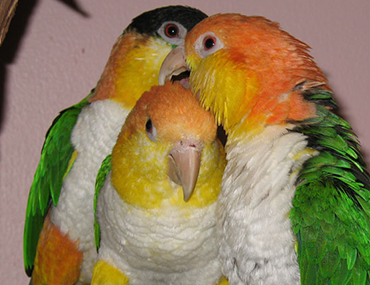
Dr. Laurie Hess gives you the information you need to welcome a new bird into your home. For more great pet tips, be sure to visit Dr. Laurie's Facebook page!
You probably didn’t know this, but January is National Adopt a Rescued Bird month, a great time to bring a new feathered friend into your home. There are thousands of abandoned, homeless birds in need of adoption, and with the aid of the Internet, you can actually see and learn about them without ever leaving your house.
With so many birds available, how do you know which one would be right for you? As a bird veterinarian, I of course love all species of birds. However, when it comes to choosing a bird to rescue, I do have a few favorites. Here is my pick of the top 5 most desirable birds, from smallest to largest, you might want to consider adopting if you are thinking about getting an avian companion:
1. Cockatiel – a great starter bird for any family. They are very gentle birds that are great with children and that can be tamed easily to sit on your hand. They also can be taught to whistle and sing. As small birds, they don’t take up lots of space and don’t make as much mess as a larger parrot, plus they can live twenty or more years when cared for properly. While they need attention daily, they are not as socially demanding as some of the larger parrots. They are also not as loud as bigger birds, so they make great birds for smaller apartments even if neighbors are close by. They do well as individuals or in pairs and are prolific egg-layers. They come in a variety of colors (yellow, white, gray) and a variety of patterns (pied, pearled, cinnamon, Lutino) and are terrific for families with children. 2. Caique – not a well-known species but definitely one of my favorites. Caiques are small to medium-sized, stocky-looking parrots that have the reputation of being very energetic and clownish. They love to be held, roll around, dance, and act silly. Mostly green, white, and orange, they come in a few different subspecies that are named based on the colors on their heads and stomach (i.e. black-headed or white-bellied). They are not excessively loud and often make close bonds with their owners. While they can make good family pets, they are not recommended for very young children, as they can sometimes nip. They can live up to 30 years if well cared for.
2. Caique – not a well-known species but definitely one of my favorites. Caiques are small to medium-sized, stocky-looking parrots that have the reputation of being very energetic and clownish. They love to be held, roll around, dance, and act silly. Mostly green, white, and orange, they come in a few different subspecies that are named based on the colors on their heads and stomach (i.e. black-headed or white-bellied). They are not excessively loud and often make close bonds with their owners. While they can make good family pets, they are not recommended for very young children, as they can sometimes nip. They can live up to 30 years if well cared for.
3. African gray parrot – perhaps one of the most familiar species. Commonly kept as pets and well known for their incredible ability to mimic and speak words, African grays are great for people who have a lot of time available to devote to a bird. Likely the smartest domesticated parrot species, African grays can be taught any number of tricks and tasks such as building puzzles, interacting with complicated toys, and even speaking words in context. They must be given a great deal of attention daily or can develop behavioral problems (such as feather picking and biting) as a result of boredom and frustration. As medium-sized parrots, they can be messy and louder than some of the smaller species and require larger cages to thrive. They can live forty or more years in captivity and often bond closely to one member of the family.
4. Amazon parrot – one of the hardiest species. Medium to large parrots with green bodies tinged with yellow, orange, blue, and red, Amazons come in a variety of subspecies all with vibrant colors. They are extremely smart and can be taught to be good talkers. They can squawk loudly and have an innate need to chew, so they need to be provided with safe wooden toys to gnaw on. As parrots known for their dominant personalities, they can be both fiercely loyal to their owners as well as strong-willed and aggressive. Consequently, they are not recommended for families with small children. They are often passed from generation to generation in families, as they can live for more than 50 years.
5. Cockatoo – the well-known, beautiful white to pink colored birds that are seen riding around on their owners shoulders. Cockatoos come in several subspecies that range in size from the smaller bare-eyed and Goffins cockatoos to the medium-sized sulfur-crested cockatoos to the larger white umbrella and salmon-colored Moluccan cockatoos. Sought after for their cuddly nature and clingy personalities, cockatoos are great for people who want a constant companion. They form very strong bonds with their owners and require more attention than other species of parrots due to their strong need to be coddled and petted. They can be very destructive and need to have wood and paper toys available constantly to chew on, or they can destroy your furniture, electronics, or other valuables in your home. They also produce a powdery substance on their feathers and skin called powder down that can be dusty (and not ideal for people with allergies) if the birds are not frequently sprayed down with water or allowed to bathe. Like African grays, if they are not given enough attention, they will scream and even chew on their own feathers and skin. However, if socialized properly and given appropriate objects on which to chew, cockatoos can make wonderful, adoring pets that love spending endless hours cuddling and hanging out with their human family members.
These are just a handful of the many hundreds of bird species available for adoption. There are many other types of birds each with their own unique attributes. Birds can make terrific, loving, and entertaining pets, but they must be matched to the right kinds of owners in the right kinds of settings to thrive. If you are considering adopting a bird, speak to a bird-savvy veterinarian about proper care and chat with other bird owners about what it’s really like to own a particular species. Learn as much as you can before you adopt. Take a look at sites like www.PetFinder.com to see what kinds of birds need homes, visit local shelters to see what birds are available, and contact bird clubs in your area to see if they have foster birds that need permanent homes. With proper knowledge and planning, you can end up with a fascinating, lovable pet that will potentially be around for you and your family to enjoy for many, many years.
If you have any questions or concerns, you should always visit or call your veterinarian – they are your best resource to ensure the health and well-being of your pets.
